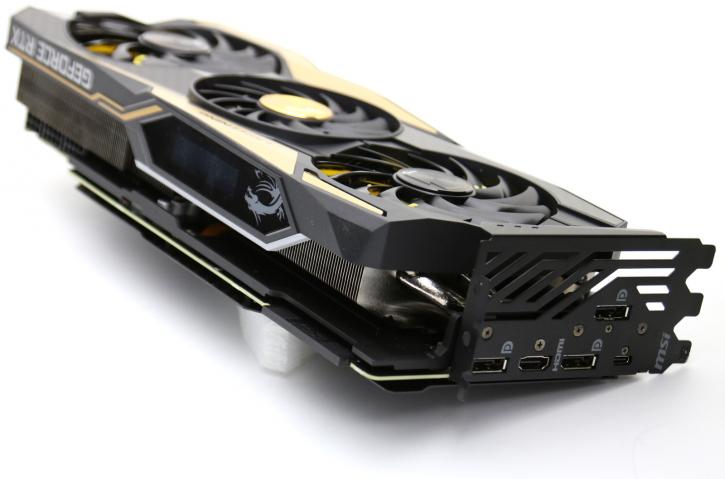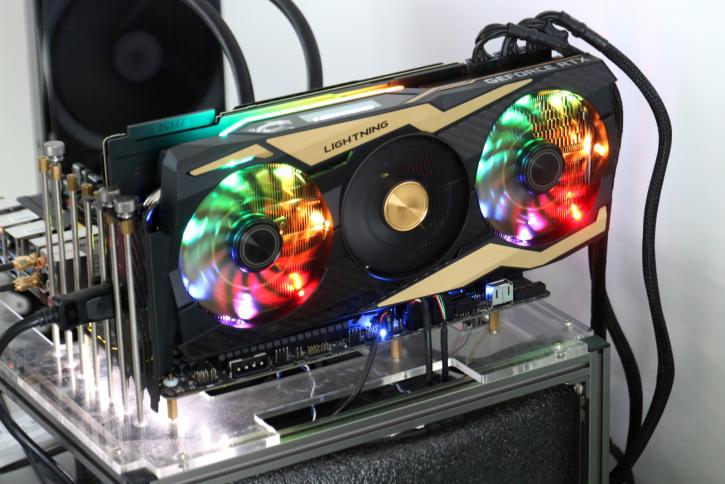Conclusion
Conclusion
MSI offers a fascinating product with the GeForce RTX 2080 Ti Lightning Z. I was surprised by the relatively low factory boost frequency at 1770 MHz, however, MSI further tweaked on the power limiter and stuff making today's tested product the fastest we've tested to date with out of the box performance. It also does it's tweaked thing at good temperatures and acoustics under heavy GPU stress. Interestingly enough MSI did not factory tweak the memory, while there it has massive tweaking potential as you have been able to see on our tweaking chapter. The new design from an aesthetic point of view is fantastic as well. You can hate and love the RGB madness from the last year or two, but on the LIGHTNING it works really well. For the haters, you can switch to a single color or even off. For the aficionados however, this look is just brilliant.
While moving onwards into the conclusion of this review I do want to point out that I will be basing my opinion on what MSI is offering here, and not particularly the NVIDIA RTX and pricing discussion okay? So yes you can discuss the 2080 Ti performance positioning overall, its validity and overall price level, we need to focus on what the board partners do with it.
Aesthetics
Well, I expressed my opinion on this topic in the previous paragraph already. I think the new Lightning is a brilliant looking card, that said, taste is trivial, as what we like you might dislike. You do need to understand that this bad boy eats away three slots, weighs in at 1.8 KG and due to the cooler is 34 cm in length. With a dark design, the cooler once powered on just looks amazing. The card does have impressive looks and even the backplate (which I typically frown upon, was done right and has been made 90% out of carbon fiber. It does give the product a very unique premium feel. The RGB lighting effects are funky to see. The new Dragon Center software still is a bit buggy though, not all of the time the RGB profile kicked in. No biggy though. Absolutely lovely is the OLED panel displaying a good number of variables and metrics. It, however, can be a little busy to look at. But yes overall, I have to say this is looking very very nice but looks are always personal, of course. So in the end, you certainly get the premium feel of detailed aesthetics and quality.
Cooling & acoustic levels
First off, this card is tweaked big time. The fact that out of the box you are already hovering in the 1970 MHz on the boost frequency is impressive, even more, impressive is that the card did that at 67 Degrees C maximum with acoustic measurements in the 37~38 DBa ranges. That extra out of the box performance does come at another price though. Any TU102 based producer sits at roughly 265 Watt TDP under full stress, our measurements show it to be quite above that number with a ~330 W measurement in power draw. So yes, MSI has been tweaking the power limiter as well. A 650 Watt PSU would be a nice match for these cards paired with a modern age PC. Remember - when purchasing a PSU, aim to double up in Wattage as your PSU is most efficient when it is at 50% load. Here, again, keep in mind we measure peak power consumption, the average power consumption is a good notch lower depending on GPU utilization. Also, if you plan to overclock the CPU/memory and/or GPU with added voltage, please do purchase a power supply with enough reserve. People often underestimate it, but if you tweak all three aforementioned variables, you can easily add 150 Watts to your peak power consumption budget as increasing voltages and clocks increase your power consumption.
Overclocking
The combination of memory, power and voltage settings will bring you a proper overclock. Once you've applied it, you get more performance. The real gurus, of course, will likely prefer a manual tweak. Here we cannot complain either. We gained 120 MHz extra on top of the extensive factory tweaked values. With the increased power limiter you'll now see that dynamic boost frequency hovering at and over the 2050~2150 MHz range. Mind you, that frequency can be higher and/or lower depending on game and benchmark title. The memory clock tweak was far more complicated, but once MSI releases it, there will be an option to tweak memory voltage as well. We did that and have been able to get the memory towards 16.55 Gbps running stable. Which is still nice when you think about it for a few seconds. We like the new OC Scanner that you will see throughout most GPU tweak utilities, for us that is Afterburner (download). While it only overclocks your GPU a notch, it does create a reliable tweaking curve. It probably needs a bit more development and fine-tuning, but I can see this become the primary methodology for automated overclocking in the future. Right now it is a little conservative though, but yes, promising. Just remember to increase the power limiter and your stable memory tweak.
Concluding
From a build quality and aesthetic point of view, the new Lightning and Lightning Z are really good. Fact remains that this uber-engineered and fantastic product series will also be hindered by the limitations set by NVAPI, NVIDIA controls your overclock. MSI, however, was able to provide intrinsic tweaks that give the product an edge over the competition. That does cost you more in some power consumption. That alone, of course, would not validate the price premium and as such MSI further extended the looks and design by adding real Carbon fiber elements, a really proper cooling system and of course the new OLED panel offering you all kinds of variables and metrics. The RGB implementation on the card really is impressive, one you juice up the card and the LEDs turn on, it is something else alright. All configurable of course. The NVIDIA GeForce RTX 2080 Ti founder's cards sell at €1299,- and this Lightning Z sitting in the 1500 USD to €1600 range. So yes, it's hard for me to justify this as a viable purchase. But the ones that fall in love with it, probably will not need any justification. This is a problem that NVIDIA created with their insane price levels, not MSI. Tweaking wise (accumulated) the card simply does not disappoint. The entire RTX 2080 Ti line is interesting but totally hindered by a too high overall market price segment. Regardless of the painful price levels and whatever you think or feel about RTX you'll have to agree with me that what MSI brought to the table here is downright impressive. MSI knows they won't sell a lot of these, but still went ahead and invested money to release this grand product anyway. And that it is, a grand product, as such I will hand out the best hardware award.
Recommended Downloads
- Sign up to receive a notice when we publish a new article
- Or go back to Guru3D's front page



